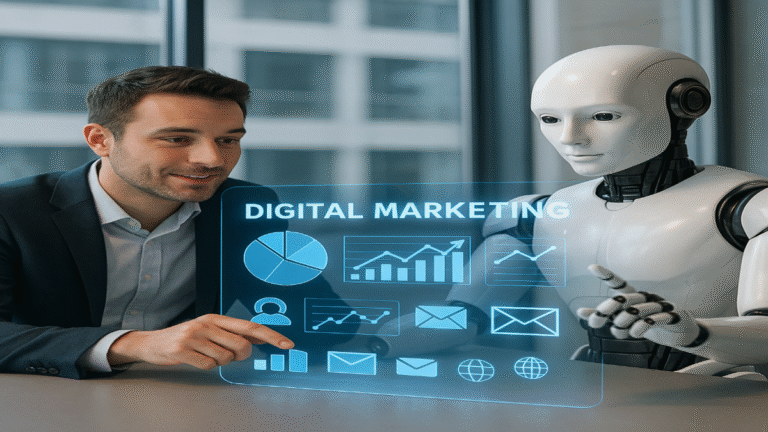Meta Description: Discover how AI creates individualized customer journeys through personalization at scale, boosting engagement and conversions in digital marketing.
Introduction
In the age of hyper-connectivity, customers no longer settle for generic marketing messages. They expect experiences tailored to their preferences, behaviors, and needs. Enter Artificial Intelligence (AI)—a game-changer that empowers marketers to craft truly individualized customer journeys at scale. By analyzing vast amounts of data in real time, AI transforms fragmented interactions into cohesive, personalized paths that drive engagement, loyalty, and conversions.
This blog explores how AI is reshaping digital marketing by enabling hyper-personalization, the technologies behind it, and actionable strategies to implement AI-driven customer journeys effectively.
What Are Individualized Customer Journeys?
A customer journey encompasses all interactions a consumer has with a brand, from discovery to post-purchase support. An individualized journey tailors each touchpoint—emails, ads, website content, chatbots, and social media interactions—to a user’s unique preferences, past behavior, and context.
Why It Matters :
- 80% of consumers are more likely to make a purchase when brands offer personalized experiences (Epsilon).
- Personalization can boost marketing ROI by 20% or more (McKinsey).
AI turns static campaigns into dynamic, adaptive interactions, ensuring every customer feels seen and valued.
How AI Powers Individualized Customer Journeys
AI leverages machine learning (ML), natural language processing (NLP), and predictive analytics to decode customer intent and automate personalization. Here’s how:
1. Data Collection and Analysis at Scale
AI aggregates and analyzes data from multiple sources:
- Website behavior (pages visited, time spent, clicks)
- Purchase history and cart abandonment rates
- Social media interactions and sentiment analysis
- Demographic and psychographic profiles
Example: Tools like Google Analytics 4 and Adobe Experience Platform use AI to identify patterns in user behavior, such as a frequent shopper favoring eco-friendly products.
2. Dynamic Segmentation and Micro-Targeting
Traditional segmentation groups users by broad categories (age, location). AI goes further with micro-segmentation, clustering users based on nuanced behaviors.
- Clustering Algorithms: Group users by similar traits (e.g., “millennial parents who buy organic products”).
- Predictive Scoring: Assign likelihood scores for actions like churn risk or upsell opportunities.
Result: A fitness brand might target users who frequently view yoga mats with a discount code, while gym equipment browsers see financing offers.
3. Predictive Personalization
AI predicts what customers want before they ask.
- Recommendation Engines: Amazon attributes 35% of its revenue to AI-driven product suggestions.
- Content Optimization: AI tools like Persado generate personalized email subject lines or ad copy optimized for specific audiences.
Example: Netflix’s AI algorithm analyzes viewing history to recommend shows, reducing user churn and boosting watch time.
4. Real-Time Interaction Management
Chatbots and virtual assistants powered by NLP deliver instant, context-aware responses.
- Drift’s AI Chatbot: Qualifies leads by asking targeted questions and routing users to the right sales rep.
- Dynamic Ads: AI adjusts ad creatives and offers in real time based on user location, device, or weather (e.g., promoting umbrellas during rain).
5. Journey Orchestration
AI maps out the optimal sequence of touchpoints for each user.
- Path Analysis: Identifies common routes to conversion (e.g., social media ad → blog post → free trial → sale).
- A/B Testing: Automates multivariate testing to refine messaging and CTAs for different segments.
Tool Spotlight: HubSpot’s COS uses AI to schedule emails at the best time for each recipient, improving open rates.
Real-World Applications of AI in Customer Journeys
Case Study 1: Sephora’s Virtual Artist
Sephora’s AI-powered AR app scans users’ faces to recommend makeup products and demonstrate looks. This interactive experience reduced returns and increased average order value by 11%.
Case Study 2: Starbucks’ Deep Brew
Starbucks’ AI platform personalizes drink recommendations in the mobile app based on past orders, time of day, and weather. Result: A 200% increase in email engagement and higher repeat purchases.
Case Study 3: Spotify’s Discover Weekly
Spotify’s AI analyzes listening habits to curate personalized playlists, driving user retention and positioning the brand as a leader in AI-driven personalization.
Challenges and Ethical Considerations
While AI offers immense potential, marketers must navigate these hurdles:
- Data Privacy Concerns: Over 60% of consumers worry about data misuse (Pew Research). Use Privacy-Enhancing Technologies (PETs) like data anonymization to comply with GDPR/CCPA.
- Bias in Algorithms: Ensure training data is diverse and audited for fairness.
- Transparency: Communicate how AI is used (e.g., “This recommendation is based on your browsing history”).
- Over-Automation: Balance AI efficiency with human empathy; avoid intrusive or “creepy” personalization.
Strategies to Implement AI-Driven Personalization
1. Start with First-Party Data
With third-party cookies phasing out, prioritize first-party data collection via:
- Loyalty programs
- Surveys and quizzes
- Website account creation
2. Invest in AI-Powered Martech Tools
- CRM Systems: Salesforce Einstein AI for lead scoring.
- Email Marketing: Mailchimp’s AI to optimize send times.
- Website Personalization: Dynamic Yield for real-time content adjustments.
3. Build an Omnichannel Experience
Ensure consistency across platforms:
- Sync AI insights between web, mobile, social, and in-store touchpoints.
- Use unified customer profiles to avoid disjointed interactions.
4. Continuously Train Your AI Models
Feed fresh data into ML algorithms to improve accuracy. For example, update product recommendations based on seasonal trends.
5. Measure and Optimize
Track KPIs like:
- Conversion rate lift from personalized campaigns
- Customer lifetime value (CLV)
- Churn reduction
The Future of AI in Customer Journeys
- Hyper-Personalization: AI will enable 1:1 content creation, such as generating unique landing pages for each visitor.
- Emotion AI: Tools analyzing voice tone or facial expressions to tailor responses (e.g., customer service bots detecting frustration).
- Autonomous Marketing: Fully automated workflows that self-optimize without human intervention.
By 2025, 75% of enterprises will use AI to personalize customer journeys, up from 30% in 2022 (Gartner).
Conclusion: AI as the Heart of Modern Marketing
AI isn’t just a tool—it’s the backbone of modern customer experience. Brands that harness its power to create individualized journeys will dominate their industries by delivering relevance at every stage.




